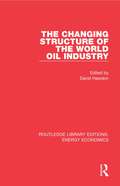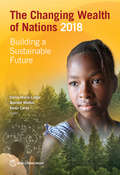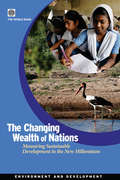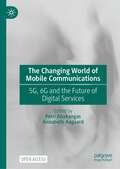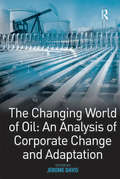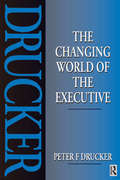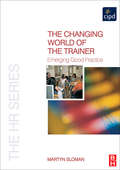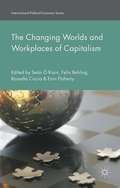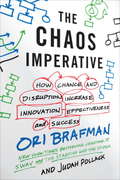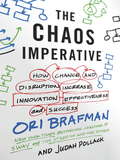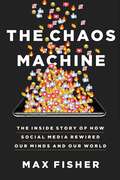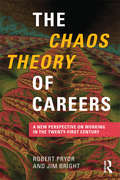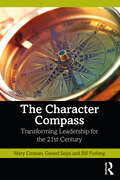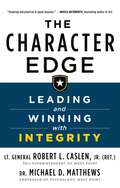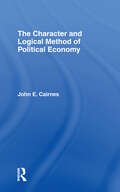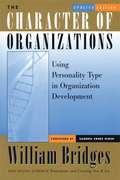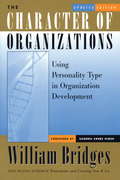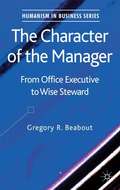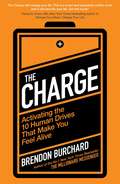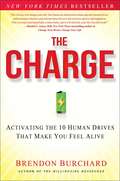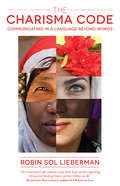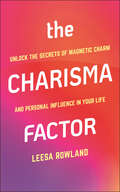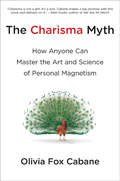- Table View
- List View
The Changing Structure of the World Oil Industry (Routledge Library Editions: Energy Economics)
by David HawdonOriginally published in 1985 by a group of international experts and oil industry officials, this book surveys the dramatic changes which took place in the oil industry in the second half of the twentieth century. It discusses the role of OPEC and the long term impact its decisions had for both producers and oil consumers and examines possible future trends in the oil industry structure and stability, together with the possible consequences for North Sea oil and gas development.
The Changing Wealth of Nations 2018: Building a Sustainable Future
by Quentin Wodon Kevin Carey Glenn-Marie LangeCountries regularly track gross domestic product (GDP) as an indicator of their economic progress, but not wealth—the assets such as infrastructure, forests, minerals, and human capital that produce GDP. In contrast, corporations routinely report on both their income and assets to assess their economic health and prospects for the future. Wealth accounts allow countries to take stock of their assets to monitor the sustainability of development, an urgent concern today for all countries. The Changing Wealth of Nations 2018: Building a Sustainable Future covers national wealth for 141 countries over 20 years (1995†“2014) as the sum of produced capital, 19 types of natural capital, net foreign assets, and human capital overall as well as by gender and type of employment. Great progress has been made in estimating wealth since the fi rst volume, Where Is the Wealth of Nations? Measuring Capital for the 21st Century, was published in 2006. New data substantially improve estimates of natural capital, and, for the fi rst time, human capital is measured by using household surveys to estimate lifetime earnings. The Changing Wealth of Nations 2018 begins with a review of global and regional trends in wealth over the past two decades and provides examples of how wealth accounts can be used for the analysis of development patterns. Several chapters discuss the new work on human capital and its application in development policy. The book then tackles elements of natural capital that are not yet fully incorporated in the wealth accounts: air pollution, marine fi sheries, and ecosystems. This book targets policy makers but will engage anyone committed to building a sustainable future for the planet.
The Changing Wealth of Nations: Measuring Sustainable Development in the New Millennium
by World BankThis book is the latest report by the World Bank to estimate comprehensive wealth -- including produced, natural and human / institutional assets -- for over 100 countries. This ground-breaking report presents wealth accounts for 1995, 2000, and 2005, permitting the first longer-term assessment of global, regional, and country performance in building wealth. This overall assessment is complemented by chapters detailing individual components of wealth, as well as how countries and the World Bank are using comprehensive measures of wealth for policy analysis.
The Changing World and Africa
by Xinfeng Li Chunying AnThis book brings contemporary Chinese scholarship into Africa, the relations between African states, and the relations between China and Africa into focus. As China becomes the biggest partner for many African states, constructing infrastructure across the continent, Western scrutiny has increased. This book offers a comprehensive look at what Chinese scholars have encountered on the ground, as well as comparative studies of how different nations have engaged with Africa.
The Changing World of Mobile Communications: 5G, 6G and the Future of Digital Services
by Annabeth Aagaard Petri AhokangasThis open access book from the world’s first 6G Flagship research program at the University of Oulu, Finland, provides a multi-disciplinary and insightful overview of the subject, with contributions from experts in the field. Today’s fourth generation of mobile connectivity services (4G) are available everywhere, and adoption of fifth generation (5G) networks is well underway. Compared to 4G, 5G has already brought about new business opportunities and enabled seamless virtual and augmented reality services, but also raised serious concerns on data privacy and security and the use of artificial intelligence. The sixth generation (6G) networks are already in R&D phase aiming at deployment in 2030. We need to understand today what 5G evolution and 6G may bring for the future of service delivery and how they will influence us. The contributions answer what 5G, its evolution, and 6G will be about; what kind of impacts 5G and 6G will have on future digital services, businesses, and society; how we could benefit from 5G and 6G innovations; and how 5G and 6G should be regulated in the future. Future 5G evolution and 6G are not only about moving toward faster, better, and more secure networks providing the basis for innovative digital services, they are also going to bring about a huge digital disruption that will affect all levels of society. This book will be of great interest to academics and students of management, telecommunications and digital innovation, as well practitioners and policymakers looking to the future of business.
The Changing World of Oil: An Analysis of Corporate Change and Adaptation
by Jerome DavisThis book examines broad questions of industrial change in order to explain developments in the oil industry. In contrast to most other work on this industry, firms are considered to be the dependent variables rather than the future production and demand for oil and gas. An analysis of the industry is made by examining how corporations change their operating environments and are themselves changed by their environments. Particular attention is paid to 'mega-mergers' and to industrial downsizing and outsourcing. The significance of such restructuring for the societies the companies serve is also considered and comprehensive use is made of recent theories of the firm. It shows how such theories can be used to analyze a key world-wide industry. The distinctive approach of this book will help extend readers' understanding of the oil industry beyond the more conventional studies.
The Changing World of Work: The Corporate Lattice as a Response to Demographic and Economic Shifts
by Molly Anderson Cathleen BenkoThe traditional corporate ladder is giving way to a new kind of organizational structure-the corporate lattice-in which success is no longer defined as a linear climb to the top. In this chapter, the authors explain how a perfect storm of demographic and economic forces has redefined the workplace, the workforce, and the nature of work itself. The need for companies to provide more and better ways to engage a diverse employee population is taking center stage, driving workplace customization as a means to build a more resilient and adaptable organizational model. Using an engaging narrative style and clear graphics, this chapter describes the shifting world of work, the changes that are propelling the transformation, and the compelling benefits of becoming a corporate lattice organization. This chapter was originally published as Chapter 2 of "The Corporate Lattice: Achieving High Performance in the Changing World of Work."
The Changing World of the Executive
by Peter DruckerThe book brings together this celebrated author's most useful ideas andinsights on ways in which managers can better understand the new duties and responsibilities created by their constantly changing world. `a brilliant collection of forty of his articles, most of which were published originally in the Wall Street Journal....absorbing even to the non-specialist' Publishers Weekly The book brings together this celebrated author's most useful ideas andinsights on ways in which managers can better understand the new duties and responsibilities created by their constantly changing world.
The Changing World of the Trainer
by Martyn SlomanThe ‘Changing World of the Trainer’ considers how the human resource development professional should undertake his or her role in today’s organization. It offers a new framework which reflects the business reality of the modern world. This practical work proceeds through a series of tools, checklists, questionnaires and instruments and presents an extensive series of illustrative case studies, drawn from organizations throughout the world.The book argues that the problems that trainers face are fundamentally the same. Their objective is to put a process in place to ensure that employees are able to acquire the knowledge and skill required by the organization. The acquisition of individual and collective knowledge and skills is not the primary purpose of the organization – skills are a means to the end of profitability and service delivery. Hence training is a derived or secondary activity. In the world economy a global model of human resource development is emerging. In one form or another, organizations are seeking to develop what are known as high performance working practices. What the customer requires drives business processes: staff must be recruited, retained and motivated. Effective learning, training and development is now essential.This does not mean the end of the traditional off-the-job training course. There are many occasions, and these are illustrated within the book, when a training course delivered by a subject-matter expert is an effective way of promoting the organization’s objectives through individual learning. However, it is increasingly evident that the range of interventions undertaken by the trainer extends far beyond the design and delivery of the training course. There has been a huge increase in coaching and in ways of promoting group learning. Action learning is undergoing a resurgence. Generally there has been a growth of non-directive forms of intervention; a shift in emphasis from instruction to the facilitation of the learning process. Many practitioners are proceeding effectively to redefine their roles in a variety of different ways. However, it is now time to offer a formal expression of the new training and learning role.Martyn Sloman is highly respected intermationally within the field of learning and development, with experience as a practitioner in the public, private and voluntary sectors.
The Changing Worlds and Workplaces of Capitalism
by Seán Ó Riain Felix Behling Rossella Ciccia Eoin FlahertyHow do the large scale structures of capitalism and the local social relations of workplaces and organisations shape each other? Through a series of European studies of capital and labour's shifting struggles and compromises; of the politics of welfare, industrial relations and labour markets; and the transformation of post-industrial networked workplaces, this edited collection shows how capitalist workplaces and economies are changing today. The first section explores how European capitalism developed and the different national forms of the struggle between capital and labour for a bigger share of national income. In the second part of the volume, the contributors investigate the institutions that are the building blocks of these different national forms, and how they are changing as labour markets are increasingly shaped by globalisation, feminisation and liberalisation. The final chapters examine how these institutions of capitalism play out in the contemporary workplace – where the most dynamic sectors are based on loose networks and external labour markets and a shifting, uncertain alliance between employers and workers. The authors argue for a new integration of political economy and the sociology of work and organisations.
The Chaos Imperative
by Ori Brafman Judah PollackIn the bestselling tradition of Switch and Made to Stick, Ori Brafman reveals how organizations can drive growth and profits by allowing contained chaos and disruption the space to flourish, generating new ideas that trigger innovation.In The Chaos Imperative, organizational expert and bestselling author Ori Brafman (Sway, The Starfish and the Spider) shows how even the best and most efficient organizations, from Fortune 500 companies to today's US Army, benefit from allowing a little unstructured space and disruption into their planning and decision-making.
The Chaos Imperative: How Chance and Disruption Increase Innovation, Effectiveness, and Success
by Ori Brafman Judah PollackFollowing the booming popularity of titles such as Switch and Made to Stick, Ori Brafman reveals how organizations can drive growth and profits by allowing contained chaos and disruption the space to flourish, generating new ideas that trigger innovation.In The Chaos Imperative, Brafman shows how even the best and most efficient organizations, from Fortune 500 companies to today's US Army, benefit from allowing a little unstructured space and disruption into their planning and decision-making.Brafman's approach is a groundbreaking new way of managing company policy and making astute, inventive choices, and can be applied to any type of organization, be they small or infinitely powerful. In our economy's current state of flux, it is crucial that we take risks, think organically and allow a little freedom for improvement to take place, and The Chaos Imperative shows us how to do this with vigour, and in an accessible, practical manner.
The Chaos Machine: The Inside Story of How Social Media Rewired Our Minds and Our World
by Max FisherFinalist for the Helen Bernstein Book Award for Excellence in JournalismFrom a New York Times investigative reporter, this &“authoritative and devastating account of the impacts of social media&” (New York Times Book Review) tracks the high-stakes inside story of how Big Tech&’s breakneck race to drive engagement—and profits—at all costs fractured the world. The Chaos Machine is &“an essential book for our times&” (Ezra Klein). We all have a vague sense that social media is bad for our minds, for our children, and for our democracies. But the truth is that its reach and impact run far deeper than we have understood. Building on years of international reporting, Max Fisher tells the gripping and galling inside story of how Facebook, Twitter, YouTube, and other social network preyed on psychological frailties to create the algorithms that drive everyday users to extreme opinions and, increasingly, extreme actions. As Fisher demonstrates, the companies&’ founding tenets, combined with a blinkered focus on maximizing engagement, have led to a destabilized world for everyone. Traversing the planet, Fisher tracks the ubiquity of hate speech and its spillover into violence, ills that first festered in far-off locales, to their dark culmination in America during the pandemic, the 2020 election, and the Capitol Insurrection. Through it all, the social-media giants refused to intervene in any meaningful way, claiming to champion free speech when in fact what they most prized were limitless profits. The result, as Fisher shows, is a cultural shift toward a world in which people are polarized not by beliefs based on facts, but by misinformation, outrage, and fear. His narrative is about more than the villains, however. Fisher also weaves together the stories of the heroic outsiders and Silicon Valley defectors who raised the alarm and revealed what was happening behind the closed doors of Big Tech. Both panoramic and intimate, The Chaos Machine is the definitive account of the meteoric rise and troubled legacy of the tech titans, as well as a rousing and hopeful call to arrest the havoc wreaked on our minds and our world before it&’s too late.
The Chaos Theory of Careers: A New Perspective on Working in the Twenty-First Century
by Jim Bright Robert PryorThe Chaos Theory of Careers outlines the application of chaos theory to the field of career development. It draws together and extends the work that the authors have been doing over the last 8 to 10 years. This text represents a new perspective on the nature of career development. It emphasizes the dimensions of careers frequently neglected by contemporary accounts of careers such as the challenges and opportunities of uncertainty, the interconnectedness of current life and the potential for information overload, career wisdom as a response to unplanned change, new approaches to vocational assessment based on emergent thinking, the place of spirituality and the search for meaning and purpose in, with and through work, the integration of being and becoming as dimensions of career development. It will be vital reading for all those working in and studying career development, either at advanced undergraduate or postgraduate level and provides a new and refreshing approach to this fast changing subject. Key themes include: Factors such as complexity, change, and contribution People's aspirations in relation to work and personal fulfilment Contemporary realities of career choice, career development and the working world
The Character Compass: Transforming Leadership for the 21st Century
by Gerard Seijts Mary Crossan Bill FurlongA guide to transforming leadership for the 21st century, this is a book about a powerful and practical framework that leaders can use to help their organizations thrive, prosper, and improve the world around them: leader character. Developed through extensive research, teaching, and outreach over the past decade, leader character is the foundation that leaders rely upon to help them make their most critical judgments. This book carries forward the authors’ important work to the implementation stage on both the individual and organizational levels. Based on the authors’ interactions with organizations in the public, private, and not-for-profit sectors around the world, they offer practical roadmaps for implementing leader character in such areas as leadership development, strategy, manifesting purpose, culture-building, executive recruitment and HR practices, EDI, risk management, and other key corporate activities. The result of these implementations is nothing less than sustained organizational excellence. Leader character is the compass that helps leaders steer their organizations through real, positive, and lasting change. This actionable book will earn its place on the bookshelves of professionals and students in talent management, leadership development, HR, and organizational development, as well as leaders from the public, private, and not-for-profit sectors.
The Character Edge: Leading and Winning with Integrity
by Michael D. Matthews Robert L. Caslen Jr.The former superintendent at West Point and a psychologist explain why all successful leaders rely on a foundation of strong character. Among the most successful leaders throughout history—from Abe Lincoln to Rosa Parks, Mahatma Gandhi to Susan B. Anthony, Martin Luther King, Jr. to Nelson Mandela—some were brilliant mathematicians and economists, others were creative visionaries, still others were masterful at strategic planning. Their mastery of their field wasn’t the secret to their highly effective leadership. All of their skill, grit, resilience, charisma, and courage emanated from one thing: their strength of character.Character—the moral values and habits of an individual—is in the spotlight now more than perhaps at any other point in modern history. Politicians distort facts. Corporations cheat customers and investors. Athletes are caught using illegal supplements. In addition to harming our culture at large, these failures of character have a profound and undermining impact on leadership.The authors of this book are experts on the value of character, its correlation with successful leadership, and how to build it in individuals and prospective leaders. General Robert L. Caslen, Jr. served the US Army for over 43 years and served as Superintendent at the US Military Academy at West Point. Psychologist Dr. Michael D. Matthews is a Professor of Engineering Psychology at West Point who has focused on the psychology of character for years. Together they witnessed firsthand that raw talent is not enough to stand on its own; successful leadership relies on the critical foundation of a strong character.In The Character Edge they leverage their perspectives to offer an empowering, story-driven argument—backed by the latest scientific research—that character is vital to success. They give readers the tools to build and sustain character in themselves and their organizations by testing readers' strengths of the gut, head and heart and teaching how to build trust and nurture the seeds of character.
The Character and Logical Method of Political Economy
by J. E. CairnesFirst Published in 1966. Routledge is an imprint of Taylor & Francis, an informa company.
The Character of Organizations: Using Personality Type in Organization Development
by William Bridges Sandra Krebs HirshAn enormous consulting industry has sprung up promising to help organizations overhaul themselves to meet today's competitive pressures. Yet far too often, such change efforts fail. The solution, according to best-selling management author William Bridges, lies in identifying, understanding and working with what he calls organizational character. Just as people have personalities, Bridges explains, organizations - as well as their departments and teams - have characters. An organization's character shapes how decisions get made and new ideas are received, how employees are treated and change is accepted or rejected - all factors that affect company performance. Using examples from McDonald's, Hewlett-Packard, GE and other companies, Bridges identifies 16 organizational character types using the framework of MBTI© personality types and shows how these influence an organization's growth and development. With a foreword by Sandra Krebs Hirsh and a new preface by the author, this updated edition of the time-tested classic includes the Organizational Character Index, Bridges' popular tool for assessing the character of your own organization or team.
The Character of Organizations: Using Personality Type in Organization Development
by William BridgesAn organization's character shapes how decisions get made and new ideas are received. In this book, William Bridges identifies 16 organizational character types using the framework of MBTI personality types and shows how these influence an organization's growth and development.
The Character of the Manager
by Gregory R. BeaboutExplores Alasdair MacIntyre's criticisms of the manager and retrieves an interdisciplinary approach to character transforming arguments. The manager as wise steward is proposed as a model for virtuous management.
The Charge
by Brendon BurchardIn The Charge, world renowned motivational speaker and bestselling author Brendon Burchard argues that in the hyper-digitized world in which we are living, the time has come to revise the classic 'hierarchy of needs' - which places the basic needs of safety and sustenance at the bottom. Burchard makes the case that it's time to re-examine what it takes to feel alive and fulfilled in a stressful, chaotic world. Using pioneering studies from the fields of positive psychology and neuroscience, as well as great stories from his own experience, Burchard identifies the ten simple drives of human emotion and happiness: Control, Competence, Congruence, Caring, Connection, Change, Challenge, Creative expression, Contribution, Consciousness. He shows how the 10 Cs, which you can use to evaluate all your thoughts, feelings, and behaviour from the past 10 days -- and in every moment of your life -- are the gateways to your psychological health and happiness. The Charge provides the keys to understanding and activating these drives in clear and concrete ways that will inspire and help everyone find the one thing we all are searching for: more life in our lives.
The Charge: Activating the 10 Human Drives That Make You Feel
by Brendon BurchardSince the fateful night of his car accident, Brendon has lived a fully charged life, and he’s helped millions of people around the globe transform their lives and feel more alive, engaged, and fulfilled.In The Charge, Brendon argues that the only way to measurably improve the quality of your life is to learn how to activate the very ten drives that make you most human. These drives are your desires for more control, competence, congruence, caring, connection, change, challenge, creative expression, contribution, and consciousness. These drives shape everything you think, feel, and do in life, so understanding and mastering them is critical to your success and happiness. Strategically activating these drives on a consistent basis is the fastest path to living a fully charged life. Harnessing our human drives is not easy; if it were, we wouldn’t see so much restlessness in the world. That’s why Brendon has devised what he calls the true “activators” of human experience—a series of powerful yet simple actions you can take to radically increase your levels of energy, engagement, and fulfillment in all areas of your life. What Brendon uncovers in The Charge will surprise and challenge you. It turns out that most of the ways we seek to meet our human drives are actually counterproductive. We all want more control, for example, but seeking to have more certainty in our daily lives or to control other people will actually decrease our levels of control (and happiness). We have a deep desire for change, too, but we often fail to make the right kinds of change that would make us feel more alive and in command of our lives. In The Charge, Brendon helps us overcome these mistakes and illuminates the path for strategically and intelligently activating our 10 human drives so that we can have the one thing we all want: more life in our lives! Brendon Burchard is the founder of High Performance Academy and author of the #1 New York Times and #1 USA TODAY bestselling book The Millionaire Messenger. He is also the author of Life’s Golden Ticket and one of the top motivation and high performance trainers in the world. His famous training events and videos inspire millions of people to find their charge, share their voice, and make a greater difference.
The Charisma Code: Communicating in A Language Beyond Words
by Robin Sol LiebermanTHE ERA OF GLOBAL CITIZENSHIP IS HERE. The Charisma Code is a hand- book for living and communicating in this new world. While we know the next big innovations will spring from global culture, it's not always clear how to join this planet-without-borders conversation.Robin Sol Lieberman's 3-step process-laid out in The Charisma Code- teaches you how to connect and collaborate with anyone, anywhere by speaking charisma's language beyond words. Whether you're an emerging global leader, a volunteer for human rights, or simply a world traveller who doesn't understand the native tongue, these steps are designed to immediately connect you to others while lighting souls and ideas on re!The Charisma Code inspires readers to choose courage over comfort, compassion over ignorance, and freedom over fear. Charisma helps com- municate who you are-the most engaging tool you can use when inviting others on your ride!
The Charisma Factor: Unlock the Secrets of Magnetic Charm and Personal Influence in Your Life
by Leesa RowlandDISCOVER THE HIDDEN SECRETS OF PERSONAL CHARM AND INFLUENCECharisma. This unique quality of confidence, natural ability and personal magnetism exists within each and every one of us, just waiting to be unlocked. But while everyone is born with the capacity for charisma, few ever take full advantage of this amazing personal gift.More than a guide to becoming popular or charming—The Charisma Factor is part mentor, part roadmap to embracing your individuality, discovering your authenticity and empowering yourself. By determining what we really want in life, we ignite the drive necessary to reach new heights and become our best possible self. This is the &“it&” factor—the charisma factor—that separates leaders from followers, students from teachers, and dreamers from doers.With The Charisma Factor, you&’ll discover . . .-The key characteristics of charismatic people-How to find—and enhance—your unique charisma factor-Effective strategies for being more charismatic in personaland professional settings-Daily tools and techniques for developing charisma-The secrets to turning charisma into authentic influenceWithin every person is a hidden spark of charisma waiting to be fanned into a flame.
The Charisma Myth
by Olivia Fox CabaneWhat if charisma could be taught? The charisma myth is the idea that charisma is a fundamental, inborn quality--you either have it (Bill Clinton, Steve Jobs, Oprah) or you don't. But that's simply not true, as Olivia Fox Cabane reveals. Charismatic behaviors can be learned and perfected by anyone. Drawing on techniques she originally developed for Harvard and MIT, Cabane breaks charisma down into its components. Becoming more charismatic doesn't mean transforming your fundamental personality. It's about adopting a series of specific practices that fit in with the personality you already have. The Charisma Myth shows you how to become more influential, more persuasive, and more inspiring.
